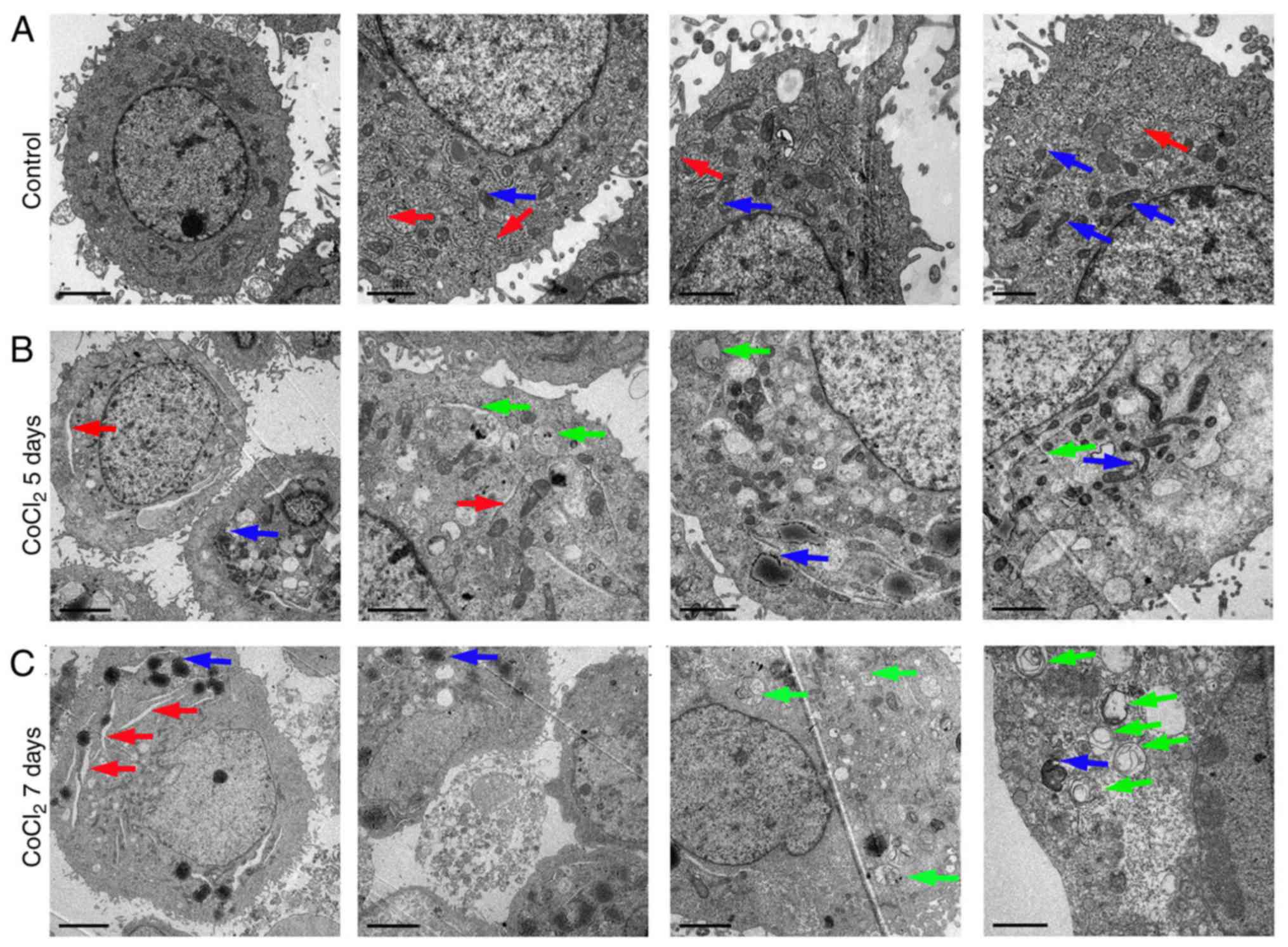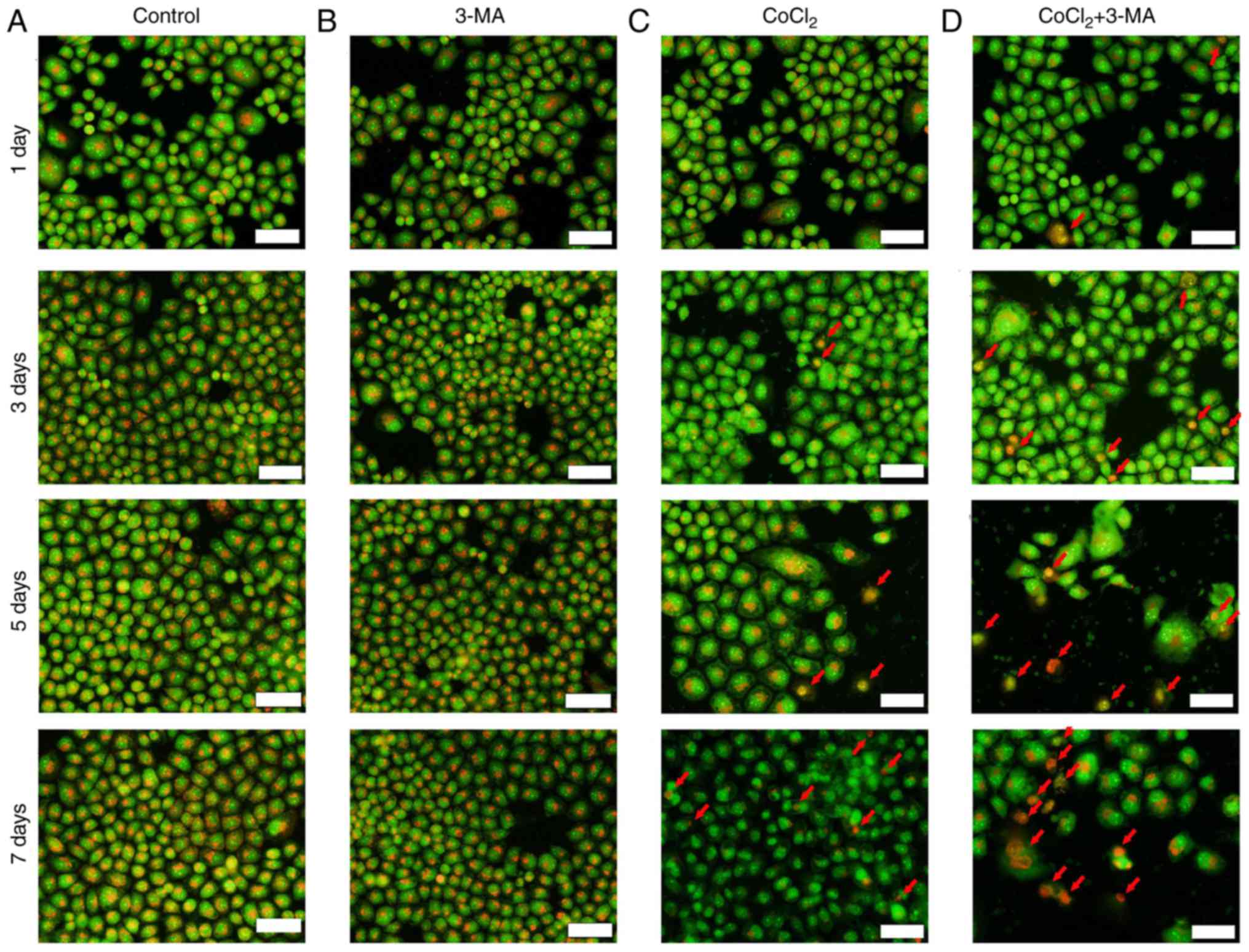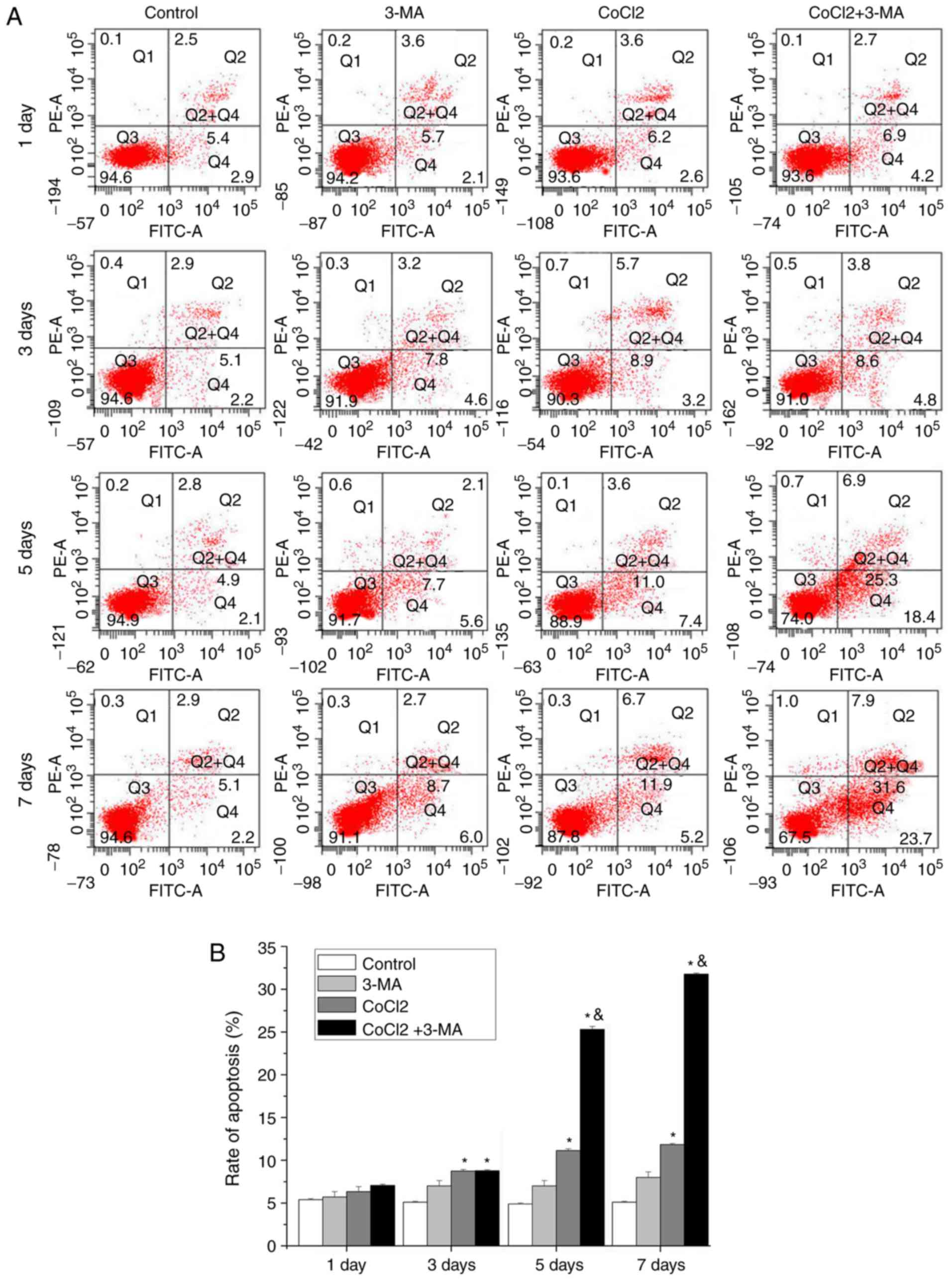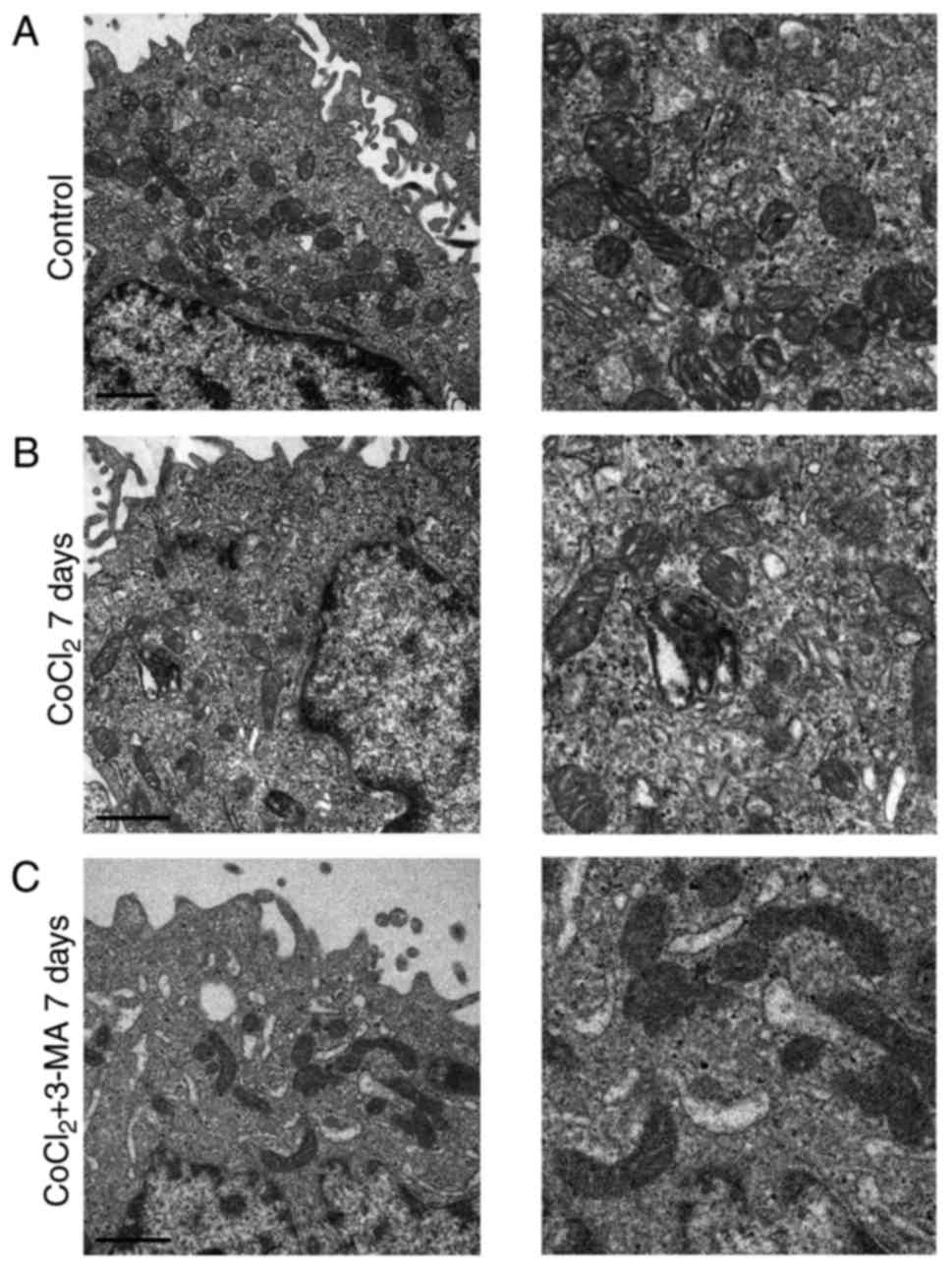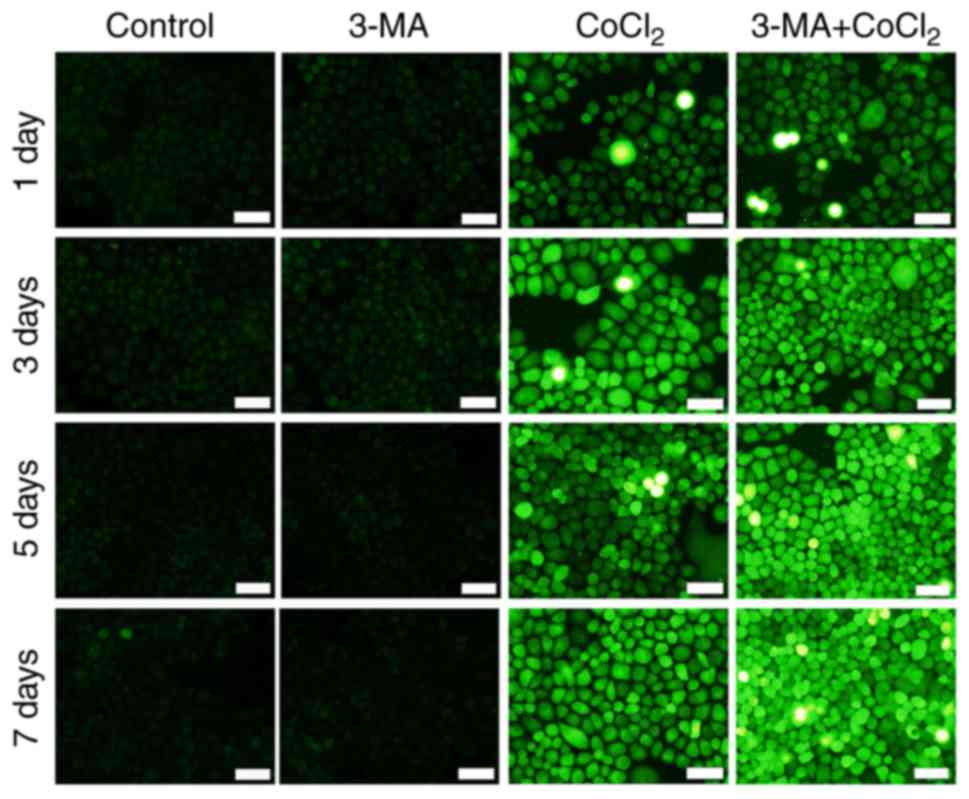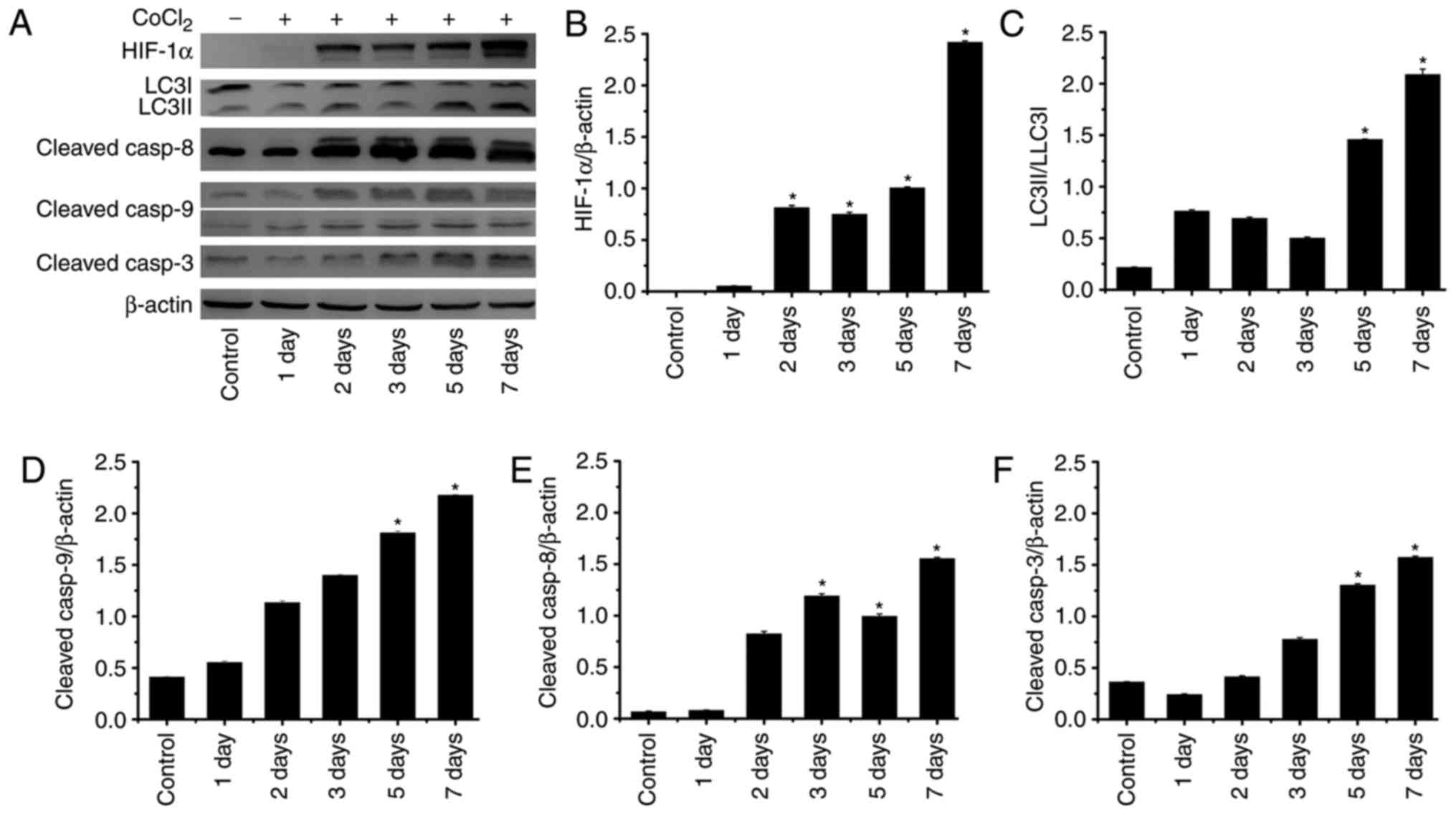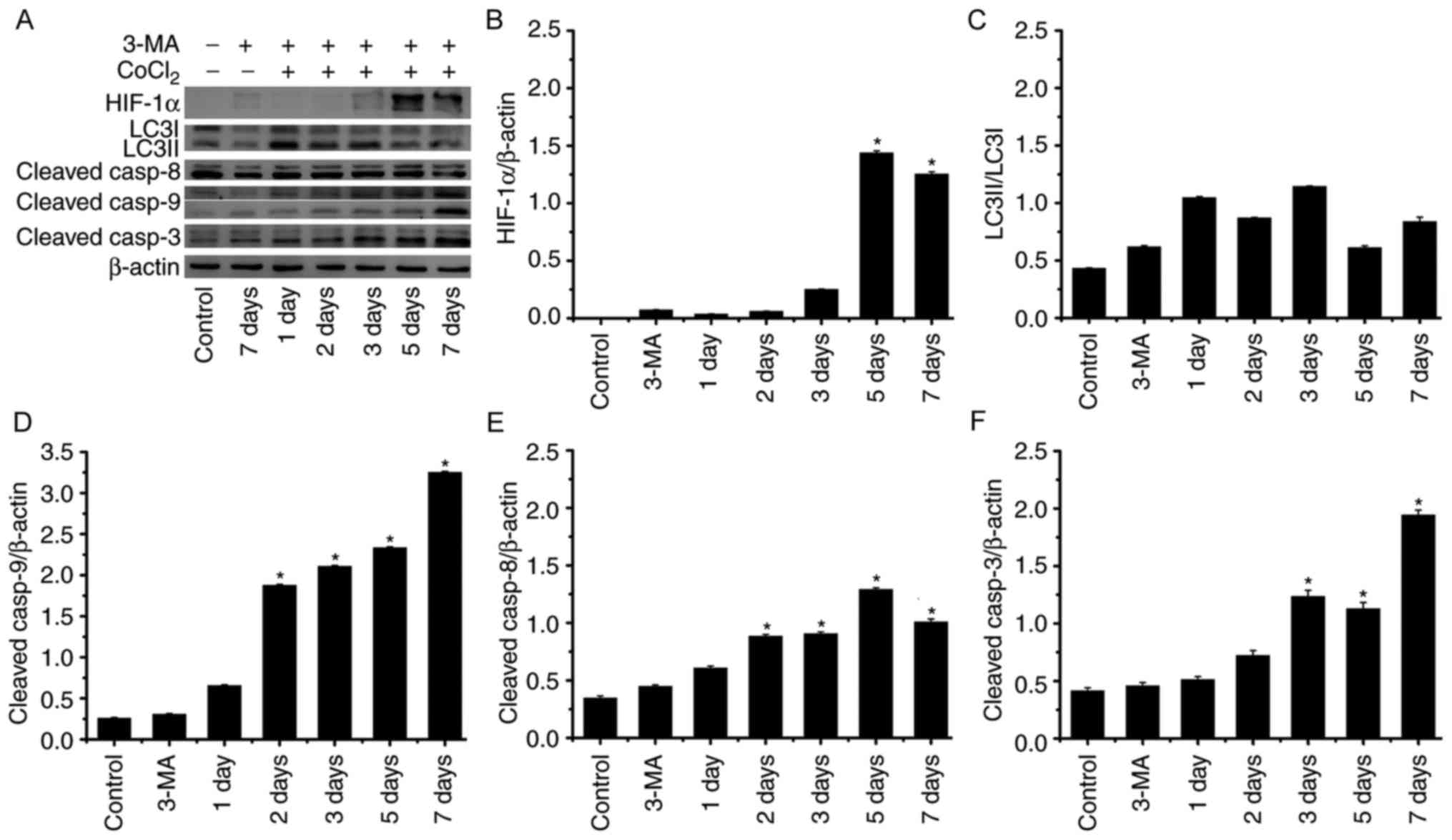Inhibition of autophagy enhanced cobalt chloride‑induced apoptosis in rat alveolar type II epithelial cells
- Authors:
- Published online on: June 22, 2018 https://doi.org/10.3892/mmr.2018.9209
- Pages: 2124-2132
-
Copyright: © Yu et al. This is an open access article distributed under the terms of Creative Commons Attribution License.
Abstract
Introduction
Hypoxia results in pathophysiological damage to various cells and tissues. Cells possess a powerful regulatory system involving hypoxia-inducible factors (HIFs) that respond to hypoxic stress (1–3). HIF-1α regulates metabolic adaptation to hypoxia and activates multiple target genes, including vascular endothelial growth factor, erythropoietin and nuclear factor-κB under hypoxic conditions (4). Furthermore, HIF-1α has been implicated as a co-regulator of autophagy activation and also participates in apoptosis (5).
Autophagy protects cells from various damaging factors, including hypoxia or starvation and maintains intracellular stability (6). It has been demonstrated that autophagy is closely associated with apoptosis under hypoxic condition (5). Apoptosis is a type of programmed cell death which is triggered by intrinsic or extrinsic signals (7). Hypoxia and cobalt (II) chloride (CoCl2) treatment activate autophagy through the target genes induced by HIF, such as mechanistic target of rapamycin (2) and correlate with the expression of certain pro-apoptotic factors, including caspase-9 and caspase-3 (8,9). These results suggest that autophagy and apoptosis often occur in parallel following CoCl2 treatment, with autophagy typically occurring prior to apoptosis. The important role of autophagy may be associated with the regulation of apoptosis. It has been reported that autophagy attenuates cellular injury by inhibiting the induction of apoptosis (10).
Autophagy and apoptosis may serve pivotal roles in neurodegenerative disease (11). A previous report revealed that autophagy serves a dual role, by exhibiting a protective role for cell survival, but autophagy may also promote apoptosis associated with various lung diseases, including chronic obstructive pulmonary disease, idiopathic pulmonary fibrosis and sepsis (12). However, the molecular mechanism of crosstalk between autophagy and apoptosis remains unclear. In the present study, the association between autophagy and apoptosis induced by long-term CoCl2 treatment in RLE-6TN cells was investigated. The results suggested that autophagy provided a survival strategy for RLE-6TN cells via apoptosis inhibition. The present study may aid in elucidating the underlying molecular mechanism of autophagy and apoptosis interaction in a hypoxic environment, which may contribute to the development of novel treatments for the therapy of lung diseases.
Materials and methods
Reagents and antibodies
CoCl2, 2,7-dichlorodihyfluorescein diacetate (DCFH-DA), Tris, glycine, Tween-20, SDS, acridine orange (AO), propidium iodide (PI), anti-microtubule associated proteins 1A/1B light chain 3B (LC3I/II; cat. no. L7543) were purchased from Sigma-Aldrich (Merck KGaA, Darmstadt, Germany). Trypsin-EDTA was obtained from Thermo Fisher Scientific, Inc. (Waltham, MA, USA). Trypsin solution without EDTA was purchased from Beyotime Institute of Biotechnology (Hangzhou, China). The Annexin V-fluorescein isothiocyanate (FITC)/PI apoptosis detection kit was purchased from BD Biosciences (San Jose, CA, USA). Primary antibodies were purchased from CST Biological Reagents, Co., Ltd. (Shanghai, China) or Abcam (Cambridge, UK). Secondary antibodies were purchased from OriGene Technologies, Inc. (Beijing, China). All other chemicals were obtained from Sigma-Aldrich (Merck KGaA). Radioimmunoprecipitation assay (RIPA) lysis buffer and phenylmethylsulfonyl fluoride (PMSF) were purchased from Beijing Solarbio Science & Technology Co., Ltd. (Beijing, China).
Cell culture and treatments
RLE-6TN cell line was provided by Binzhou Medical University (Yantai, China). Cells were cultured in RPIM-1640 medium (Hyclone; GE Healthcare Life Sciences, Logan, UT, USA) supplemented with 10% fetal bovine serum (Hyclone; GE Healthcare Life Sciences) and maintained at 37°C in a humidified atmosphere with 5% CO2. Hypoxia was established with CoCl2 (100 µM) as previously described (13,14). The concentration of the autophagy inhibitor 3-methyladenine (3-MA; 1.5 mM) was determined by creating a dose-response curve in a preliminary experiment (data not shown). RLE-6TN cells were plated in 10-cm diameter plastic dish until 70–80% confluence was attained. Cells were treated with or without CoCl2 and/or 3-MA for 1, 3, 5 and 7 days at 37°C.
Transmission electron microscopy (TEM)
For ultrastructural observation, cells were fixed with 2.5% paraformaldehyde and 2% glutaraldehyde in 0.1 M phosphate buffer (pH 7.4) for 2 h at 4°C. Cells were subsequently post-fixed at 4°C with 1% osmium tetroxide for 1 h and dehydration was performed using 50, 70, 80, 95 and 100 ethanol, and 100% acetone sequentially every 15 min and embedded in Epon 812 resin at 37°C for 12 h, at 45°C for 12 h and 60°C for 36 h. Following this, cells were cut into ultrathin sections, imposed on a copper grid and stained with uranyl acetate for 30 min and led citrate for 10 min at room temperature. Observations and photographs were obtained using a JEOL JEM 1,011 microscope with a MORADA camera (JEOL Ltd., Tokyo, Japan).
Reactive oxygen species (ROS) assay
DCFH-DA was used to detect ROS levels. DCFH-DA converts into the highly fluorescent DCF upon oxidation by ROS. Cultured RLE-6TN cells were plated at a density of 1×105 cells/ml in 6-well plates and incubated with RPIM-1640 medium supplemented with 10% fetal bovine serum overnight at 37°C. DCFH-DA working solution was added directly to the medium to reach 20 µM and incubated at 37°C for 30 min. Cells were subsequently washed with PBS three times and visualized with a fluorescence microscope (excitation wavelength, 488 nm; magnification, ×200).
AO/PI double staining
RLE-6TN cells (80–90% confluence) were plated in 24 well-plates on a glass slide at 37°C for 24 h. Following incubation, the cells in control group and treated RLE-6TN cells were harvested and washed twice with PBS. Glass slides were subsequently stained with 10 µg/ml of AO/PI for 5 min in the dark at 37°C, followed by washing with PBS three times. Stained cells were observed under a fluorescence microscope (excitation wavelength, 488 nm; magnification, ×200).
Annexin V/PI apoptosis assay
To analyze apoptosis, the FITC Annexin V Apoptosis Detection kit (BD Biosciences) was used according to the manufacturer's protocols. Treated cells (1×106) were washed with binding buffer of the aforementioned kit and resuspended in 100 µl binding buffer containing 5 µl FITC and 5 µl PI. After 15 min of incubation at room temperature in the dark, 400 µl binding buffer was added and the apoptotic rate of cells was analyzed with a flow cytometer (FACSDiva Software 6.0, BD Biosciences).
Western blot analysis
RLE-6TN cells were lysed in ice-cold RIPA lysis buffer (1 ml RIPA; 10 µl PMSF) for 30 min. Protein concentration was determined with a bicinchoninic acid protein assay kit and proteins (50 µg/lane) were separated by 12 and 15% SDS-PAGE and transferred to polyvinylidene fluoride membranes. Membranes were blocked at room temperature for 2 h with 5% skimmed milk in Tris-buffered saline with 0.1% Tween-20 (cat. no. ST825; Beyotime Institute of Biotechnology) and subsequently probed with the following antibodies at 4°C overnight: Anti-β-actin antibody (1:2,000; cat. no. bs-0061R; BIOSS; Beijing, China), Anti-HIF-1α (1:1,000; cat. no. 14179; CST Biological Reagents Co., Ltd.), anti-LC3I/II (1:1,000; cat. no. L7543; Sigma-Aldrich; Merck KGaA), anti-cleaved caspase-9 (1:300; cat. no. ab2325; Abcam), anti-caspase-8 (1:1,000; cat. no. ab25901; Abcam), anti-cleaved caspase-3 (1:1,000; cat. no. 9664; CST Biological Reagents Co., Ltd.). Following this, membranes were incubated with horseradish peroxidase-conjugated goat anti-rabbit IgG (1:5,000; ZB2301; OriGene Technologies, Inc.) antibody for 1 h at room temperature. Proteins were visualized with an enhanced chemiluminescence substrate kit (Clinx Science Instruments Co., Ltd., Shanghai, China) and standard X-ray film development (ChemiScope 3,300 mini; Clinx Science Instruments Co., Ltd.). Results were quantified with ImageJ software v1.48 (National Institutes of Health, Bethesda, MD, USA) and processed using Adobe Photoshop CS5 (Adobe Systems, Inc., San Jose, CA, USA).
Statistical analysis
All experiments were performed at least three times. The data were expressed as the mean ± standard deviation. Statistical analyses were performed using SPSS 17.0 (SPSS, Inc., Chicago, IL, USA). Data were analyzed by one-way analysis of variance followed by Fisher's least significant difference. P<0.05 was considered to indicate a statistically significant difference.
Results
Hypoxia induces organelle impairment and autophagosome generation
Previous studies have demonstrated that cancer cells adapt to hypoxia or nutrient deprivation through autophagy activation (15,16). In the present study, TEM was used to observe the ultrastructure following CoCl2 treatment in RLE-6TN cells (Fig. 1). Compared with untreated cells (Fig. 1A), numerous autophagosomes consisting of double membranes were observed in the CoCl2-treated RLE-6TN cells on days 5 and 7 (Fig. 1B and C, respectively). No notable autophagosomes were observed after 1 and 3 days following treatment with CoCl2 (data not shown). Cytoplasmic material and/or membrane vesicles were encapsulated in the autophagosomes. Furthermore, swollen endoplasmic reticuli and damaged mitochondria were also observed following CoCl2 treatment (Fig. 1B and C). These results indicated that 100 µm CoCl2 treatment resulted in severe organelle impairment and induced autophagy generation.
3-MA enhances apoptosis in hypoxic conditions
Apoptosis is characterized by distinct morphological features and energy-dependent biochemical mechanisms. Cell pyknosis, cell shrinkage and chromatin condensation typically occur in early apoptosis (17,18). Budding in late apoptosis is a result of extensive blebbing of the plasma membrane to form apoptotic bodies containing tightly packed organelles (19). In the present study, fluorescence microscopy was used to detect the morphological changes in RLE-6TN cells following CoCl2 and/or 3-MA treatment for 1, 3, 5 and 7 days (Fig. 2A-D). CoCl2 treatment resulted in a reddish-orange color in nucleus due to the binding of PI to denatured DNA. Lysosomes in the cytoplasm were stained orange by PI in Fig. 2. This abundance of apoptotic cells, as indicated by arrows, was more prominent as the incubation time increased. 3-MA markedly increased the number reddish-orange stained nuclei in 100 µm CoCl2-treated cells (Fig. 2D). These results indicated that autophagy was associated with apoptosis in RLE-6TN cells in hypoxic conditions and that autophagy may have a protective role in a hypoxic environment.
The apoptotic effect induced by CoCl2 was further confirmed by flow cytometry (Fig. 3A). The results demonstrated that CoCl2 treatment significantly increased in the percentage of cells in upper right and lower right quadrants (early and late apoptotic cells, respectively) after 3 days of treatment. 3-MA significantly increased CoCl2-induced apoptosis in RLE-6TN cells at days 5 and 7 (P<0.05; Fig. 3B).
Taken together, these results suggested that the inhibition of autophagy strongly accelerated the process of apoptosis.
Inhibiting autophagy increases mitochondrial damage
Mitochondria have a double-membrane structure and are key organelles for the production of energy (20). In addition, mitochondria regulate cellular redox signaling pathways and programmed cell death (20). In order to explore the effect of 3-MA in CoCl2-treated mitochondria, TEM was used to examine the mitochondrial ultrastructure. As presented in Fig. 4, swollen mitochondria were observed following CoCl2 treatment at day 7, compared with the control. Mitochondrial damage was not notably observed on day 3; however, more notable damage was reported on day 5 (data not shown). Notably, more marked mitochondrial damage was observed in the CoCl2 + 3-MA group, including severely swollen mitochondria, double-membrane destruction and loss of normal morphology, suggesting that the inhibition of autophagy increased the extent of mitochondrial damage in RLE-6TN cells under hypoxic conditions.
Inhibiting autophagy increases the production of ROS
ROS are critical regulators in various cellular processes, including autophagy and apoptosis (21,22). Mitochondria are a major source of ROS in cells (23). A fluorescent probe, DCFH-DA, was used to detect the generation of ROS. As presented in Fig. 5, DCFH-DA fluorescence was markedly increased following CoCl2 and 3-MA treatment, compared with CoCl2 treatment alone. The results revealed that the inhibition of autophagy with 3-MA increased ROS generation and increased the rate of apoptosis in RLE-6TN cells. These results indicated that autophagy may prevent cell impairment in a hypoxic environment.
3-MA upregulates the expression of caspases in hypoxic conditions
Autophagy and apoptosis are two important catabolic processes (24) and the relationship between them remains unclear. In order to explore the complex crosstalk between autophagy and apoptosis, the expression of several proteins associated with these processes in response to hypoxia was investigated. As presented in Fig. 6, HIF-1α expression was significantly upregulated on days 2, 3, 5 and 7 after treatment with CoCl2. This data indicated that the hypoxia model was successfully conducted in our study. In addition, cleaved-caspase-9, cleaved-caspase-8, cleaved-caspase-3, LC3II/I exhibited increasing trend; the expression levels were significantly higher on days 5 and 7 compared with in the control. Notably, 3 days following CoCl2 treatment, cleaved-caspase-8 also significantly increased. Following 3-MA treatment (Fig. 7), the expression levels of LC3II/LCI, key proteins in autophagy, did not exhibit significant alterations under hypoxic conditions compared with in the control. By contrast, expression levels of cleaved caspase-9 and cleaved caspase-3 were significantly increased, particularly on days 5 and 7. Compared with cleaved-caspase-9 and cleaved-caspase-3, the expression level of cleaved caspase-8 appeared to be upregulated to a lesser degree. These results indicated that autophagy and apoptosis occurred in RLE-6TN cells under hypoxic conditions. Inhibition of autophagy may have accelerated apoptosis, predominantly through caspase-9-mediated intrinsic pathways in RLE-6TN cells in a chronic hypoxic environment.
Discussion
Cellular stress stimuli, such as hypoxia, may induce cells to exhibit their dual role (25). Cells may activate cytoprotective pathways, such as autophagy, to favor survival until the stress is resolved. Conversely, cells also may undergo programmed cell death. CoCl2 has been extensively used as a reagent to establish hypoxia in vitro (26–29). In the present study, autophagy and apoptosis occurred in RLE-6TN cells following exposure to CoCl2. The association between these two processes is complex.
Autophagy serves an essential role in cellular catabolism (30). Autophagy is a process which involves the engulfment of cytoplasmic materials and intracellular organelles within autophagosomes, which are subsequently delivered to lysosomes (31). The materials within autophagolysosomes provide energy in order to maintain cell metabolism. Cell survival may be impeded if autophagy is interrupted (32). By contrast, excessive autophagy may lead to a type of cell death known as autophagic apoptosis (33). Apoptosis is a highly controlled genetic program of cell death, which also serves a critical role in determining cell fate. Apoptosis is triggered by multiple signaling pathways, including the extrinsic and intrinsic signaling pathways (34). Zhang et al (35) demonstrated that the inhibition of autophagy with 3-MA increases apoptosis in a mouse model of middle cerebral artery occlusion (MCAO). In addition, hypoxia-induced autophagy decreases the production of cytochrome c and the activation of caspase-mediated apoptotic pathways (35). Therefore, the ischemia-induced neuronal injury is depressed in an MCAO model following treatment with 3-MA. Yan et al (36) demonstrated that chronic ischemia induces autophagy in the heart, and the areas of damaged heart have fewer apoptotic cells due to an increase in autophagy. By contrast, Cheng et al (14) revealed that pre-treatment of human malignant glioma U87-MG cells in hypoxic conditions with autophagy inhibitors suppresses cell apoptosis and caspase-3 activation. These studies were performed in different experimental models and suggest that there is a complex interaction between autophagy and apoptosis. Examining the potential underlying mechanisms of interaction in various environments of cellular stress will aid in the understanding of the relationship between autophagy and apoptosis.
Evidence suggests that mitochondria are the main intracellular source of ROS in cells (37,38). ROS participate in various cellular processes, including autophagy and apoptosis (39). Accumulation of ROS impairs mitochondrial function (40). In response to diverse pathological conditions, including oxidative stress, autophagy serves a dual role by exhibiting protective and harmful effects, which promote cell survival and apoptosis, respectively (12,41). Dewaele et al (42) demonstrated that ROS-dependent accumulation of LC3-PE facilitates autophagosome formation. Previous studies have demonstrated that autophagy may inhibit apoptosis in hypoxic conditions through ROS removal and inhibition of caspase activation (43,44). Chien et al (45) revealed that following ischemia/reperfusion in the kidney, autophagy serves a central role in ROS clearance and prevents apoptosis. The results of the present study were consistent with this finding: An increase in mitochondrial damage and dysfunction was observed following autophagy inhibition with 3-MA, resulting in increased ROS production. In addition, the expression levels of apoptosis-associated proteins were increased following autophagy inhibition, including caspase-9, caspase-8 and caspase-3. Furthermore, the number apoptotic cells increased. It is well established that the intrinsic apoptotic pathway is predominantly dependent on caspase-9, and the extrinsic apoptotic pathway is predominantly mediated by caspase-8 (14). Notably, the expression level of caspase-9 may have increased faster and to a greater degree compared with caspase-8 following 3-MA treatment. Therefore, the results of the current study demonstrated that 3-MA treatment in hypoxic conditions increased the production of ROS and the apoptotic rate, primarily through the caspase-9-dependent intrinsic apoptotic pathway. Furthermore, these results suggested that autophagy may serve a protective role in the early stages of lung damage in a hypoxic environment.
In conclusion, autophagy served a protective role in RLE-6TN cells, via inhibition of ROS production and prevention of apoptosis in hypoxic conditions. The present study only investigated the effects of one inhibitor in one cell line. Therefore, further research is required to provide further evidence, in order to explore the potential molecular mechanisms between hypoxia-induced autophagy and apoptosis. This may provide new insights into pulmonary disease surveillance, diagnosis and treatment.
Acknowledgements
Not applicable.
Funding
The present study was supported by the Natural Science Foundation of Shandong Province (grant no. ZR2014HL005), the Scientific Research Foundation of Fang Han Team, the National Natural Science Foundation of Youth Fund (grant no. 81600069), the Natural Science Foundation of Shandong Province (grant nos. ZR2013HL005 and ZR2013CL003) and the Scientific Research Foundation of Binzhou Medical University (grant no. BY2013KYOD12).
Availability of data and materials
Not applicable.
Author's contributions
YY made substantial contributions to the conception and design of the present study. WL conducted the AO-PI staining, western blotting, ROS detection and drafted the manuscript. LR conducted western blotting, analyzed the data and critically revised the manuscript for important intellectual content. CY conducted TEM. DL and XH made substantial contributions to western blotting. YS conducted flow cytometry. CL and FH analyzed the data and critically revised the manuscript for important intellectual content. FH revised the manuscript and gave final approval of the version to be published.
Ethics approval and consent to participate
Not applicable.
Consent for publication
Not applicable.
Competing interests
The authors declare that they have no competing interests.
References
|
Jeong JK, Gurunathan S, Kang MH, Han JW, Das J, Choi YJ, Kwon DN, Cho SG, Park C, Seo HG, et al: Hypoxia-mediated autophagic flux inhibits silver nanoparticle-triggered apoptosis in human lung cancer cells. Sci Rep. 6:216882016. View Article : Google Scholar : PubMed/NCBI | |
|
Semenza GL: HIF-1, O(2), and the 3 PHDs: How animal cells signal hypoxia to the nucleus. Cell. 107:1–3. 2001. View Article : Google Scholar : PubMed/NCBI | |
|
Huang LE and Bunn HF: Hypoxia-inducible factor and its biomedical relevance. J Biol Chem. 278:19575–19578. 2003. View Article : Google Scholar : PubMed/NCBI | |
|
Haase VH: The VHL tumor suppressor: Master regulator of HIF. Curr Pharm Des. 15:3895–3903. 2009. View Article : Google Scholar : PubMed/NCBI | |
|
Bellot G, Garcia-Medina R, Gounon P, Chiche J, Roux D, Pouysségur J and Mazure NM: Hypoxia-induced autophagy is mediated through hypoxia-inducible factor induction of BNIP3 and BNIP3L via their BH3 domains. Mol Cell Biol. 29:2570–2581. 2009. View Article : Google Scholar : PubMed/NCBI | |
|
Ozpolat B and Benbrook DM: Targeting autophagy in cancer management-strategies and developments. Cancer Manag Res. 7:291–299. 2015. View Article : Google Scholar : PubMed/NCBI | |
|
Gordy C and He YW: The crosstalk between autophagy and apoptosis: Where does this lead? Protein Cell. 3:17–27. 2012. View Article : Google Scholar : PubMed/NCBI | |
|
Volm M and Koomägi R: Hypoxia-inducible factor (HIF-1) and its relationship to apoptosis and proliferation in lung cancer. Anticancer Res. 20:1527–1533. 2000.PubMed/NCBI | |
|
Piret J, Lecocl C, Toffoli S, Ninane N, Raes M and Michiels C: Hypoxia and CoCl2 protect HepG2 cells against serum deprivation- and t-BHP-induced apoptosis: A possible anti-apoptotic role for HIF-1. Exp Cell Res. 295:340–349. 2004. View Article : Google Scholar : PubMed/NCBI | |
|
Pan T, Rawal P, Wu Y, Xie W, Jankovic J and Le W: Rapamycin protects against rotenone-induced apoptosis through autophagy induction. Neuroscience. 164:541–551. 2009. View Article : Google Scholar : PubMed/NCBI | |
|
Ghavami S, Shojaei S, Yeganeh B, Ande SR, Jangamreddy JR, Mehrpour M, Christoffersson J, Chaabane W, Moghadam AR, Kashani HH, et al: Autophagy and apoptosis dysfunction in neurodegenerative disorders. Prog Neurobiol. 112:24–49. 2014. View Article : Google Scholar : PubMed/NCBI | |
|
Li T, Jiao YR, Wang LH, Zhou YH and Yao HC: Autophagy in myocardial ischemia reperfusion injury: Friend or foe? Int J Cardiol. 239:102017. View Article : Google Scholar : PubMed/NCBI | |
|
Wang G, Hazra TK, Mitra S, Lee HM and Englander EW: Mitochondrial DNA damage and a hypoxic response are induced by CoCl(2) in rat neuronal PC12 cells. Nucleic Acids Res. 28:2135–2140. 2000. View Article : Google Scholar : PubMed/NCBI | |
|
Cheng BC, Chen JT, Yang ST, Chio CC, Liu SH and Chen RM: Cobalt chloride treatment induces autophagic apoptosis in human glioma cells via a p53-dependent pathway. Int J Oncol. 50:964–974. 2017. View Article : Google Scholar : PubMed/NCBI | |
|
Pouysségur J, Dayan F and Mazure NM: Hypoxia signalling in cancer and approaches to enforce tumour regression. Nature. 441:437–443. 2006. View Article : Google Scholar : PubMed/NCBI | |
|
Kim J and Klionsky DJ: Autophagy, cytoplasm-to-vacuole targeting pathway, and pexophagy in yeast and mammalian cells. Annu Rev Biochem. 69:303–342. 2000. View Article : Google Scholar : PubMed/NCBI | |
|
Häcker G: The morphology of apoptosis. Cell Tissue Res. 301:5–17. 2000. View Article : Google Scholar : PubMed/NCBI | |
|
Ovadje P, Chatterjee S, Griffin C, Tran C, Hamm C and Pandey S: Selective induction of apoptosis through activation of caspase-8 in human leukemia cells (Jurkat) by dandelion root extract. J Ethnopharmacol. 133:86–91. 2011. View Article : Google Scholar : PubMed/NCBI | |
|
Rajagopalan V and Yusuf AH: Hannun: Sphingolipid metabolism and signaling as a target for cancer treatmentCell death signaling in cancer biology and treatment. Johnson DE: Humana Press; New York: pp. 205–229. 2013, View Article : Google Scholar | |
|
Heo JM and Rutter J: Ubiquitin-dependent mitochondrial protein degradation. Int J Biochem Cell Biol. 43:1422–1426. 2011. View Article : Google Scholar : PubMed/NCBI | |
|
Simon HU, Haj-Yehia A and Levi-Schaffer F: Role of reactive oxygen species (ROS) in apoptosis induction. Apoptosis. 5:415–418. 2000. View Article : Google Scholar : PubMed/NCBI | |
|
Scherz-Shouval R and Elazar Z: Regulation of autophagy by ROS: Physiology and pathology. Trends Biochem Sci. 36:30–38. 2011. View Article : Google Scholar : PubMed/NCBI | |
|
Hasanain M, Bhattacharjee A, Pandey P, Ashraf R, Singh N, Sharma S, Vishwakarma AL, Datta D, Mitra K and Sarkar J: α-Solanine induces ROS-mediated autophagy through activation of endoplasmic reticulum stress and inhibition of Akt/mTOR pathway. Cell Death Dis. 6:e18602015. View Article : Google Scholar : PubMed/NCBI | |
|
Wu H, Che X, Zheng Q, Wu A, Pan K, Shao A, Wu Q, Zhang J and Hong Y: Caspases: A molecular switch node in the crosstalk between autophagy and apoptosis. Int J Biol Sci. 10:1072–1083. 2014. View Article : Google Scholar : PubMed/NCBI | |
|
Rubinstein AD and Kimchi A: Life in the balance-a mechanistic view of the crosstalk between autophagy and apoptosis. J Cell Sci. 125:5259–5268. 2012. View Article : Google Scholar : PubMed/NCBI | |
|
Merelli A, Caltana L, Girimonti P, Ramos AJ, Lazarowski A and Brusco A: Recovery of motor spontaneous activity after intranasal delivery of human recombinant erythropoietin in a focal brain hypoxia model induced by CoCl2 in rats. Neurotox Res. 20:182–192. 2011. View Article : Google Scholar : PubMed/NCBI | |
|
Badr GA, Zhang JZ, Tang J, Kern TS and Ismail-Beigi F: Glut1 and glut3 expression, but not capillary density, is increased by cobalt chloride in rat cerebrum and retina. Brain Res Mol Brain Res. 64:24–33. 1999. View Article : Google Scholar : PubMed/NCBI | |
|
Zou W, Yan M, Xu W, Huo H, Sun L, Zheng Z and Liu X: Cobalt chloride induces PC12 cells apoptosis through reactive oxygen species and accompanied by AP-1 activation. J Neurosci Res. 64:646–653. 2001. View Article : Google Scholar : PubMed/NCBI | |
|
Zhu X, Zhou W, Cui Y, Zhu L, Li J, Feng X, Shao B, Qi H, Zheng J, Wang H and Chen H: Pilocarpine protects cobalt chloride-induced apoptosis of RGC-5 cells: Involvement of muscarinic receptors and HIF-1 alpha pathway. Cell Mol Neurobiol. 30:427–435. 2010. View Article : Google Scholar : PubMed/NCBI | |
|
Ouyang L, Shi Z, Zhao S, Wang FT, Zhou TT, Liu B and Bao JK: Programmed cell death pathways in cancer: A review of apoptosis, autophagy and programmed necrosis. Cell Prolif. 45:487–498. 2012. View Article : Google Scholar : PubMed/NCBI | |
|
Levine B and Kroemer G: Autophagy in the pathogenesis of disease. Cell. 132:27–42. 2008. View Article : Google Scholar : PubMed/NCBI | |
|
Boya P, González-Polo RA, Casares N, Perfettini JL, Dessen P, Larochette N, Métivier D, Meley D, Souquere S, Yoshimori T, et al: Inhibition of macroautophagy triggers apoptosis. Mol Cell Biol. 25:1025–1040. 2005. View Article : Google Scholar : PubMed/NCBI | |
|
Zhu H, Tannous P, Johnstone JL, Kong Y, Shelton JM, Richardson JA, Le V, Levine B, Rothermel BA and Hill JA: Cardiac autophagy is a maladaptive response to hemodynamic stress. J Clin Invest. 117:1782–1793. 2007. View Article : Google Scholar : PubMed/NCBI | |
|
Zhao Y, Li R, Xia W, Neuzil J, Lu Y, Zhang H, Zhao X, Zhang X, Sun C and Wu K: Bid integrates intrinsic and extrinsic signaling in apoptosis induced by alpha-tocopheryl succinate in human gastric carcinoma cells. Cancer Lett. 288:42–49. 2010. View Article : Google Scholar : PubMed/NCBI | |
|
Zhang X, Yan H, Yuan Y, Gao J, Shen Z, Cheng Y, Shen Y, Wang RR, Wang X, Hu WW, et al: Cerebral ischemia-reperfusion-induced autophagy protects against neuronal injury by mitochondrial clearance. Autophagy. 9:1321–1333. 2013. View Article : Google Scholar : PubMed/NCBI | |
|
Yan L, Vatner DE, Kim SJ, Ge H, Masurekar M, Massover WH, Yang G, Matsui Y, Sadoshima J and Vatner SF: Autophagy in chronically ischemic myocardium. Proc Natl Acad Sci USA. 102:13807–13812. 2005. View Article : Google Scholar : PubMed/NCBI | |
|
Park J, Min JS, Kim B, Yun JW, Choi MS, Kong IK, Chang KT and Lee DS: Mitochondrial ROS govern the LPS-induced pro-inflammatory response in microglia cells by regulating MAPK and NF-κB pathways. Neurosci Lett. 584:191–196. 2015. View Article : Google Scholar : PubMed/NCBI | |
|
Hou JT, Li K, Yang J, Yu KK, Liao YX, Ran YZ, Liu YH, Zhou XD and Yu XQ: A ratiometric fluorescent probe for in situ quantification of basal mitochondrial hypochlorite in cancer cells. Chem Commun (Camb). 51:6781–6784. 2015. View Article : Google Scholar : PubMed/NCBI | |
|
Ravikumar B, Sarkar S, Davies JE, Futter M, Garcia-Arencibia M, Green-Thompson ZW, Jimenez-Sanchez M, Korolchuk VI, Lichtenberg M, Luo S, et al: Regulation of mammalian autophagy in physiology and pathophysiology. Physiol Rev. 90:1383–1435. 2010. View Article : Google Scholar : PubMed/NCBI | |
|
Lemasters JJ, Nieminen AL, Qian T, Trost LC, Elmore SP, Nishimura Y, Crowe RA, Cascio WE, Bradham CA, Brenner DA and Herman B: The mitochondrial permeability transition in cell death: A common mechanism in necrosis, apoptosis and autophagy. Biochim Biophys Acta. 1366:177–196. 1998. View Article : Google Scholar : PubMed/NCBI | |
|
Shintani T and Klionsky DJ: Autophagy in health and disease: A double-edged sword. Science. 306:990–995. 2004. View Article : Google Scholar : PubMed/NCBI | |
|
Dewaele M, Maes H and Agostinis P: ROS-mediated mechanisms of autophagy stimulation and their relevance in cancer therapy. Autophagy. 6:838–854. 2010. View Article : Google Scholar : PubMed/NCBI | |
|
Grishchuk Y, Ginet V, Truttmann AC, Clarke PG and Puyal J: Beclin 1-independent autophagy contributes to apoptosis in cortical neurons. Autophagy. 7:1115–1131. 2011. View Article : Google Scholar : PubMed/NCBI | |
|
Li M, Gao P and Zhang J: Crosstalk between autophagy and apoptosis: Potential and emerging therapeutic targets for cardiac diseases. Int J Mol Sci. 17:3322016. View Article : Google Scholar : PubMed/NCBI | |
|
Chien CT, Shyue SK and Lai MK: Bcl-xL augmentation potentially reduces ischemia/reperfusion induced proximal and distal tubular apoptosis and autophagy. Transplantation. 84:1183–1190. 2007. View Article : Google Scholar : PubMed/NCBI |



